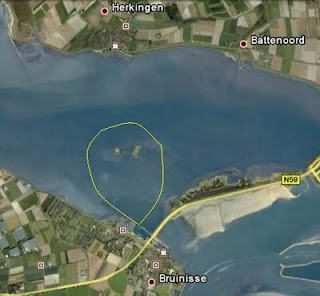So it was past 1pm when we motored out of the harbour and than sailed NW following the main navigation channel of the Grevelingen, pushed along by a very gentle wind. On a broad reach, we were doing less than 2 knots. But with the sun shining and summer temperature we enjoyed the lazy sailing.
 |
| Sandra (First-Mate) at the helm in glorious weather and flat seas. Notice our convenience flag. |
Mekicevica livened-up, and the sequence of tacks made the trip even more enjoyable for boat, crew,… and a stowaway (see photo). Well, paying passenger if you accept as payment the regurgitated crab meat left on the motor.
 |
| Luis (Skipper) and a stowaway |
The Grevelingen in such nice weather and on a long weekend, can be very busy. Sort of The Solent on a Bank Holiday in good weather. It keeps your knowledge of the colregs sharp. So it was that while beating on a starboard tack, we found ourselves on collision course with a similar sized boat on port tack. Worryingly, she did not seem to change course or speed, and the bearing kept constant and the distance between us getting shorter and shorter. I started to think what evasive action I should take that would not create a confusing situation and possibly a collision. Since we were close-hauled, just a tiny, nearly unnoticeable turn to windward was enough to slow us down and pass a couple of meters astern of the other boat. As I shouted my protest, the guy on the other boat was surprised and really embarrassed as he offered his apologies. Sitting on the gunwales on the weather side, his view had been obstructed by his sail and he only noticed us, when I shouted at him.
Time to return to port. The sudden change of wind meant that we had a bit of fun beating, and then could sail downwind, reversing the very same route that we had done on a broad reach just a couple of hours before.
Unfortunately, work commitments forced us to be home on Easter Monday. After the misadventures of launching, we did not feel like facing recovering that soon, so we paid for a visitors berth for a week. Mekicevica is impatiently waiting for her crew until next weekend.
Time to return to port. The sudden change of wind meant that we had a bit of fun beating, and then could sail downwind, reversing the very same route that we had done on a broad reach just a couple of hours before.
Unfortunately, work commitments forced us to be home on Easter Monday. After the misadventures of launching, we did not feel like facing recovering that soon, so we paid for a visitors berth for a week. Mekicevica is impatiently waiting for her crew until next weekend.



